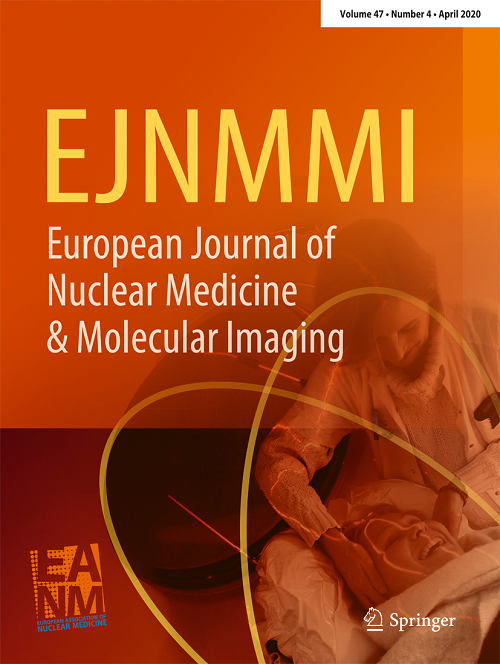[18F]FAZA PET/MR成像在慢性肢体缺血血运重建前后的预后价值:组织微循环的前瞻性试点研究。
IF 7.6
1区 医学
Q1 RADIOLOGY, NUCLEAR MEDICINE & MEDICAL IMAGING
European Journal of Nuclear Medicine and Molecular Imaging
Pub Date : 2025-08-15
DOI:10.1007/s00259-025-07514-6
引用次数: 0
摘要
目的评价[18F]FAZA PET对行血管内重建术的危重肢威胁性缺血(CLTI)患者长期临床预后的预测价值。方法本前瞻性先导研究获得了IRB和伦理委员会的批准。计划接受血运重建术的患者被招募。所有患者在血运重建术前后两个不同的时间点进行动态和静态[18F]FAZA PET检查。建模后,从每次扫描中提取动态[18F]FAZA pet衍生参数(包括K1、K2、K3、K4、Ki和总体积分布[VT]),并计算delta参数。此外,从静态[18F]FAZA PET计算标准化摄取值。此外,在血运重建术前后测量踝臂指数(ABIs)。对患者进行临床随访。所有的主要事件都被记录下来,并相应地将患者分为两组:“持续反应”和“治疗失败”。结果12例前瞻性招募患者(平均年龄69岁)中,5例患者在随访期间被诊断为治疗失败。血管成形术后的K1 (p = 0.012)和ABI (p = 0.006)与血管成形术前的评估有显著差异,分别显著降低和升高。在经历持续临床反应的患者中,K1 (p = 0.028;治疗后显著降低),VT (p = 0.018;治疗后显著增高),ABI (p = 0.028;血管成形术后与血管成形术前有显著性差异。在治疗失败的患者中,只有VT (p = 0.043;治疗后显著降低),差异有统计学意义。考虑组间差异,持续缓解组与治疗失败组的ΔVT差异显著(p = 0.003)。结论我们的研究结果可以支持动态[18F]FAZA初始体积分布在血运重建前后的变化的潜在预后价值。与ABI等显示组织大血管通畅的传统测量方法不同,动态[18F]FAZA PET可以通过VT制图捕捉组织级微循环。本文章由计算机程序翻译,如有差异,请以英文原文为准。
Prognostic value of [18F]FAZA PET/MR imaging pre and post revascularization in chronic limb-threatening ischemia: a prospective pilot study on tissue microcirculation.
PURPOSE
To evaluate the prognostic value of [18F]FAZA PET in predicting long-term clinical outcomes of critical limb-threatening ischemia (CLTI) patients undergoing endovascular revascularization.
METHODS
This prospective pilot study received IRB and ethics committee approval. Patients who were planned to undergo revascularization were recruited. All patients underwent both dynamic and static [18F]FAZA PET at two different time points, before and after revascularization. After modelling, dynamic [18F]FAZA PET-derived parameters (including K1, K2, K3, K4, Ki, and total volume distribution [VT]) were extracted from each scan, and delta parameters were calculated. Also, standardized uptake values were calculated from the static [18F]FAZA PET. Furthermore, ankle-brachial indices (ABIs) were measured before and after revascularization. Patients were followed up clinically. All major events were documented, and patients were classified into two groups accordingly: "sustained response" and "therapy failure".
RESULTS
From the 12 prospectively recruited patients (mean age = 69 years), five patients were diagnosed with therapy failure during follow-up. K1 (p = 0.012) and ABI (p = 0.006) were significantly different in the post-angioplasty setting versus pre-angioplasty evaluations, being significantly lower and higher, respectively. In patients who experienced sustained clinical response, K1 (p = 0.028; significantly lower after treatment), VT (p = 0.018; significantly higher after treatment), and ABI (p = 0.028; significantly higher after treatment) were significantly different after angioplasty versus before angioplasty. In patients with therapy failure, only VT (p = 0.043; significantly lower after treatment) was significantly different. Considering between-group differences, ΔVT was significantly different between those who experienced sustained response versus those with therapy failure (p = 0.003).
CONCLUSION
Our findings could support the potential prognostic value of changes in dynamic [18F]FAZA's initial volume distribution in the pre- versus post-revascularization setting. Unlike traditional measures, such as ABI, which show tissue's macrovasculature patency, dynamic [18F]FAZA PET could capture tissue-level microcirculation by VT mapping.
求助全文
通过发布文献求助,成功后即可免费获取论文全文。
去求助
来源期刊
CiteScore
15.60
自引率
9.90%
发文量
392
审稿时长
3 months
期刊介绍:
The European Journal of Nuclear Medicine and Molecular Imaging serves as a platform for the exchange of clinical and scientific information within nuclear medicine and related professions. It welcomes international submissions from professionals involved in the functional, metabolic, and molecular investigation of diseases. The journal's coverage spans physics, dosimetry, radiation biology, radiochemistry, and pharmacy, providing high-quality peer review by experts in the field. Known for highly cited and downloaded articles, it ensures global visibility for research work and is part of the EJNMMI journal family.

 求助内容:
求助内容: 应助结果提醒方式:
应助结果提醒方式:


